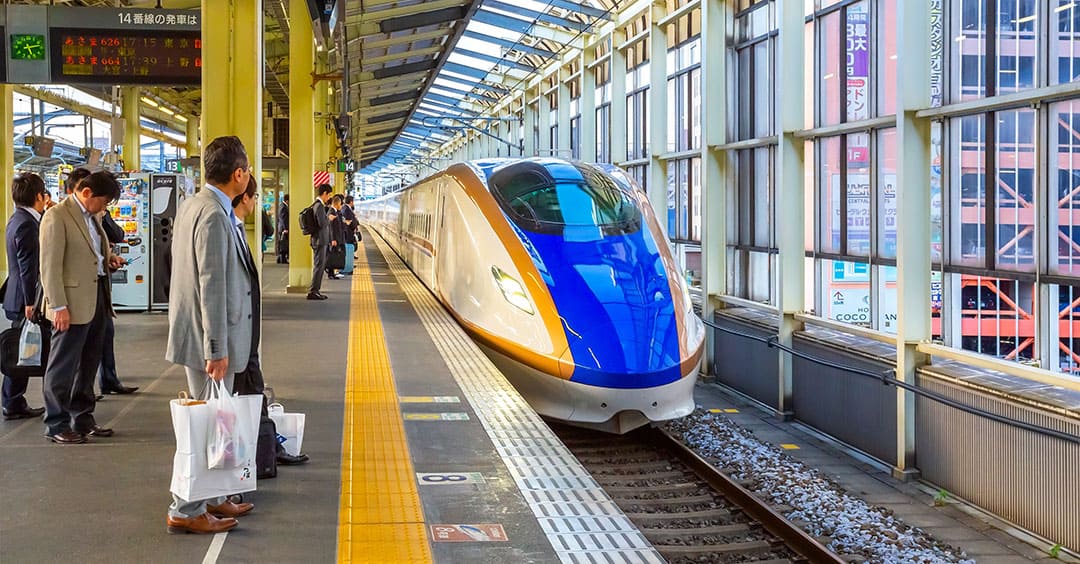There are several ways to travel between Tokyo and Kyoto, but bullet trains (also named shinkansen) are no doubt the fastest and most convenient way to do so.
Keeping that in mind, below I’ve written a comprehensive guide in which I’ll tell you everything you need to know about them, such as where to board, where you can buy your tickets, and more.
About the Shinkansen Network & Its Trains
Shinkansen is the Japanese word for bullet train. They’re operated by Japan Railways (JR) Group company and mostly run on dedicated tracks, connecting Tokyo with most of Japan’s major cities.
The bullet train network has some of the fastest trains in the world, running at up to 320 km/h. The trains are also known for being comfortable, safe, efficient, and very punctual, with an average delay of only 36 seconds.
The Tokaido Bullet Train
Among the shinkansen network’s 9 lines, the most widely used is the Tokaido Shinkansen. It reaches speeds of up to 285 km/h, and connects Tokyo with Nagoya, Kyoto and Osaka over a distance of 552.6 km.
There are three types of trains on the Tokaido Shinkansen line: the Nozomi, Hikari, and Kodama.
The Nozomi is the fastest train with 4 departures per hour and only 4 stops, reaching Kyoto from Tokyo in just 2 hours and 20 minutes. However, the Nozomi is one of the few trains that can’t be used with the Japan Rail Pass.
The Hikari is the 2nd fastest train, serving up to 10 stops with 2 departures per hour. It travels between Tokyo and Kyoto in 2 hours and 40 mins, so it’s your best choice if you want to make the journey using a JR Pass
The Kodama is the slowest train, serving all stations between Tokyo and Shin-Osaka. It takes 4 hours to reach Shin-Osaka from Tokyo, with 2 departures per hour. As the travel time is significantly longer, taking this train is typically not advised unless you need to stop somewhere the other 2 trains don’t.
All 3 shinkansen trains cost the same if you choose a non-reserved seat. However, reserved seats cost more than non-reserved seats, with the Nozomi reserved seats costing the most among the 3 train services.
Shinkansen Seat Classes & Reservations
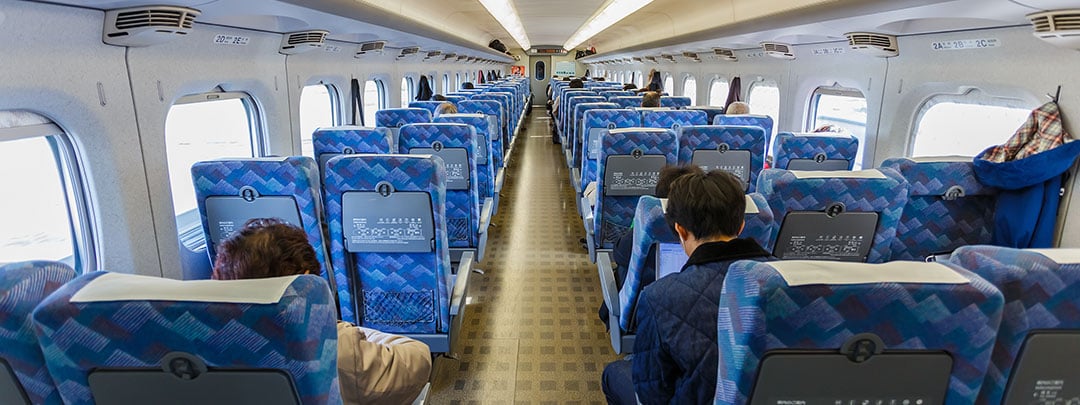
In this section, I’ll introduce you to the different seat classes you’ll typically find in shinkansen trains, which are found in separate cars.
Ordinary Car
Pictured above, these are the regular seats found on all shinkansen trains. They usually come in rows of 3 + 2 seats, and are comfortable with a good amount of foot space.
Green Car
This is the business class equivalent of shinkansen seats. The Green Cars have larger and more comfortable seats arranged in a 2 + 2 layout, and have more foot space. All seats in Green Cars are reserved seats.
Reserved vs non-reserved cars
Most shinkansen trains also have non-reserved seats and reserved seats in separate cars, with only a few carrying fully reserved cars. To use seats in reserved cars, advance reservations have to be made for a fee. However, JR Pass holders can reserve seats for free.
Are seat reservations recommended?
In most cases, you won’t need a reserved ticket to get a seat on shinkansen trains. You can just buy an ordinary ticket, and take the next train available.
However, trains sometimes to get booked out during rush hour (between 7-9 am, and 4-7 pm), and peak travel days such as New Year and Golden Week holidays. If you’re planning to travel during these times, do consider buying reserved tickets.
Tokyo to Kyoto Bullet Train
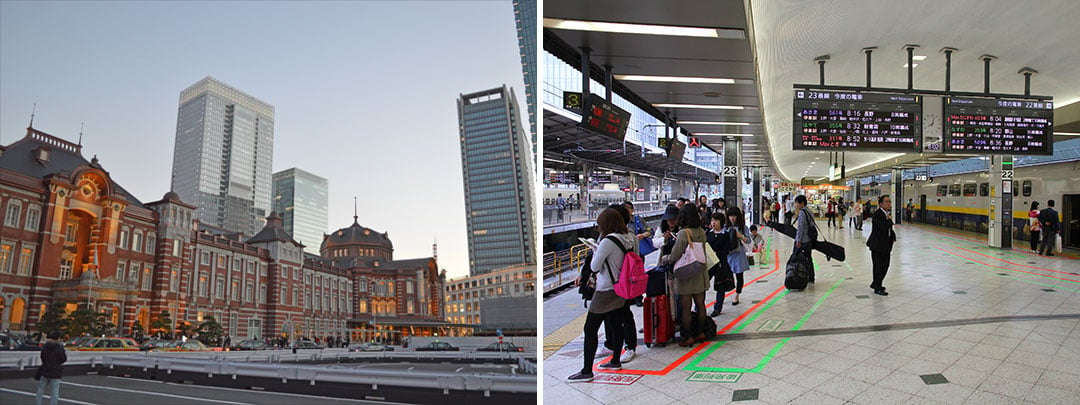
From Tokyo, you can board the shinkansen from either Tokyo Station, or Shinagawa Station. Nozomi trains run every 10 minutes from 6 to 9 pm, while Hikari trains run every 30 minutes from 6:26 to 10 pm.
A one-way journey with an unreserved seat costs the same on all 3 shinkansen trains. However, with reserved seats, a one-way journey costs ~420 JPY more on the Hikari and Kodama, and ~630 JPY more on the Nozomi. For JR Pass holders, this journey is free with the Hikari and Kodama trains.
If you prefer to buy tickets online instead of at the station, you can click here to buy Tokyo to Kyoto shinkansen tickets online (also handy for price info).
Kyoto to Tokyo Shinkansen
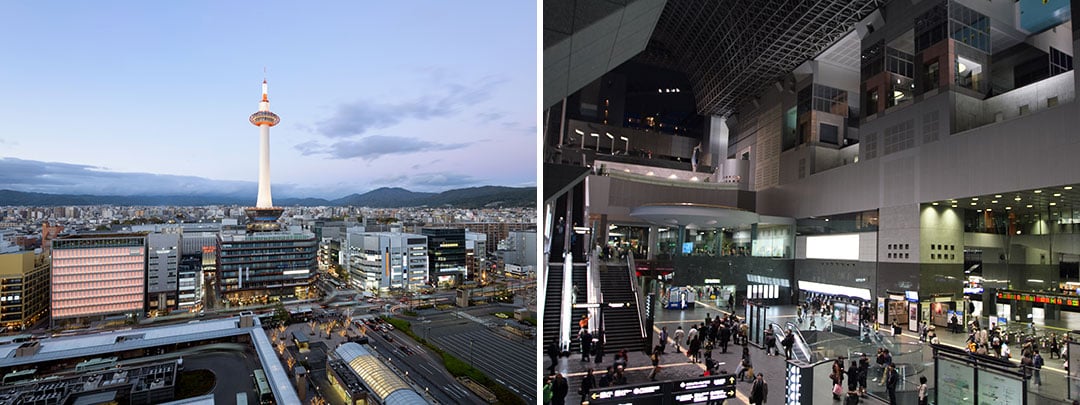
From Kyoto, you can board the shinkansen from Kyoto Station. Entering the station from either Central, Hachijo, or Hachijo East gate will give you direct access to the shinkansen. Nozomi trains run every 10 minutes from 6:14 to 10:46 am daily, while Hikari trains runs every 30 minutes from 6:23 am – 8:49 pm.
A one-way journey with an unreserved seat costs the same on all 3 shinkansen trains. However, with reserved seats, a one-way journey costs ~420 JPY more on the Hikari and Kodama, and ~630 JPY more on the Nozomi. For JR Pass holders, this journey is free with the Hikari and Kodama trains.
If you prefer to buy tickets online instead of at the station, you can click here to buy Kyoto to Tokyo shinkansen tickets online (also handy for price info).
JR Pass vs Individual Tickets
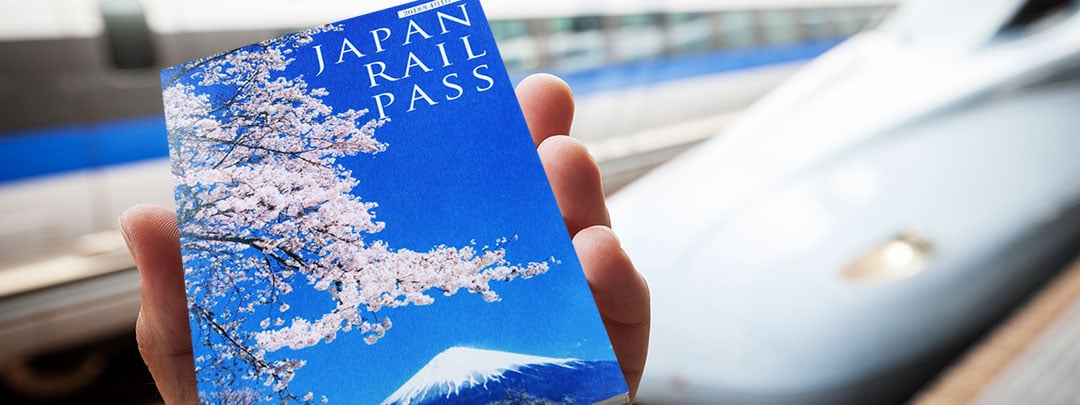
The JR Pass is designed for foreign tourists and allows unlimited use of JR trains, including the shinkansen. The JR pass can typically save you a lot of money if you plan to travel within Japan…
For example, a normal shinkansen return journey from Tokyo to Kyoto costs 26,160 JPY, and a one-way trip on the Narita Express into Tokyo costs 3,020 JPY. An ordinary 7-day JR Pass costs 29,100 JPY. Therefore, getting from Narita Airport to Tokyo, then to Kyoto and back with the JR Pass would save you money already.
However, if your itinerary does not require many long-distance train trips, a JR Pass may not pay off for you and you could buy individual train tickets instead. The JR Pass also limits you from traveling on the Nozomi bullet train line, which has faster and more frequent trains.
If you plan to use a JR Pass for your travels, see the 7, 14 and 21-day JR Passes available on Klook
How to Book Bullet Train Tickets
Here I’ll introduce to you the different ways to buy shinkansen tickets. The details on how to book them online or buy them at JR train stations are laid out below.
Buying at a ticket counter or machine
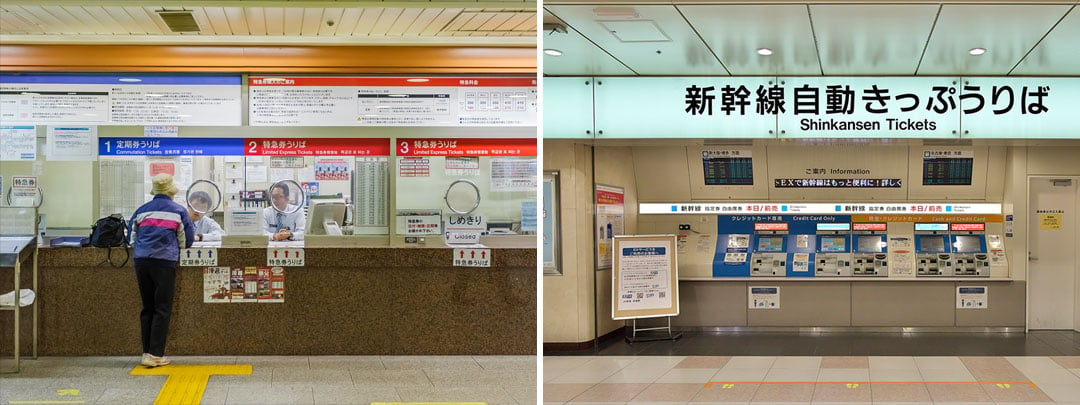
You can buy shinkansen tickets at ticket offices at all major and many other minor JR stations throughout Japan. To purchase tickets, you’ll need the following information:
- Number of travelers
- Date of travel
- Departure and destination stations
- Ordinary or Green Car
- Reserved or non-reserved seat
To reserve a seat, the following is also required:
- Train name (e.g. Hikari), train number or departure time
- Smoking or non-smoking seat preference
Ticket office agents may have limited English language skills, so if you don’t speak Japanese, it’s best to write down the above information and pass it to the agent when you buy your tickets to make the process faster.
You can also buy bullet train tickets at some ticket machines. Most of them have menus in English. However, there are some limitations to using them. Not all machines sell reserved seats, and some do not accept credit cards issued outside Japan.
Buying tickets online
You can also buy reserved-seat shinkansen tickets online through reputable sites like Klook and Rakuten. Both sites are in English, and have many positive reviews from customers who have bought the tickets there.
Tickets on Klook are the cheapest, with a normal one-way trip from Tokyo to Kyoto or vice versa priced at around 14,110 JPY (~130 USD). When you arrive in Japan, you’ll need to present your Klook voucher for an exchange order, and use that to redeem the actual bullet train ticket at selected JR stations.
Tickets on Rakuten are slightly more expensive, with a normal one-way trip from Tokyo to Kyoto or vice versa priced from 16,660 JPY (160 USD). However, Rakuten also gives you the ability to buy Green Car tickets, and also have your tickets delivered directly to your hotel.
Conclusion
Taking the shinkansen is a fast, convenient and cost-effective way to travel between Tokyo and Kyoto.
In short, here are my answers to some of the most common questions:
Which bullet train train should I take?
The Hikari shinkansen is the best train to take if you have a JR Pass. Otherwise, the Nozomi train is the fastest.
Should I get a JR pass to use the shinkansen?
If you are planning a trip with a lot of long-distance travel, a JR Pass will greatly help with reducing costs. Otherwise, buying individual train tickets would be better.
Where can I buy shinkansen tickets?
You can buy them online or at almost all JR stations nationwide. However, buying online is the best option if you can’t speak Japanese, or if you want a smoother experience where you can skip queues and pick up tickets upon arrival or have them delivered to your hotel.
That’s it, this guide should help you have a smooth experience when you travel between Tokyo and Kyoto with a bullet train 🙂
